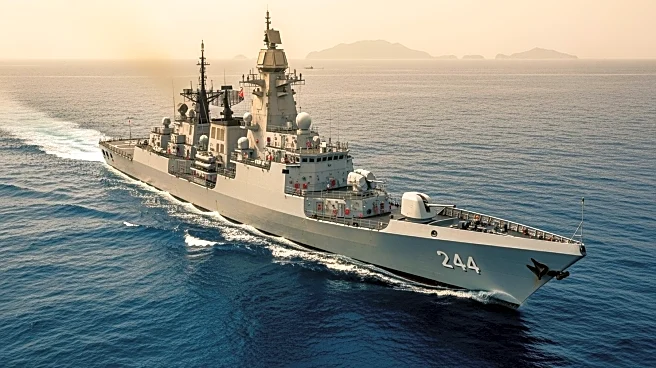What's Happening?
India has extended its naval reach near China, deploying a warship to South Korea as part of a broader Indo-Pacific strategy. The Indian frigate INS Sahyadri arrived in Busan, South Korea, marking the
first-ever naval drill between the two countries. This deployment is part of India's operational presence in the South China Sea and the Indo-Pacific region, areas where China has asserted significant territorial claims. The exercise includes both harbor and sea phases, with South Korea deploying the frigate ROKS Gyeongnam for joint operations. This move is seen as part of India's strategic alignment with countries like the United States, Australia, and Japan, countering China's growing influence in the region.
Why It's Important?
The deployment of the Indian warship underscores the strategic tensions between India and China, both nuclear-armed nations with a long-standing border dispute. India's naval maneuvers in the Indo-Pacific region reflect its efforts to strengthen ties with regional allies and counter China's expansive claims in the South China Sea. This strategic alignment is crucial for maintaining balance in a region where China's naval capabilities continue to grow. The presence of Indian naval forces in these contested waters highlights the geopolitical significance of the Indo-Pacific, as nations seek to secure their interests and maintain regional stability.
What's Next?
The future deployment of the Indian warship remains uncertain, with potential plans to transit the Taiwan Strait, a critical international waterway claimed by China. Such a move could further escalate tensions between India and China, as Beijing asserts sovereignty over the strait. The ongoing naval exercises between India and South Korea may lead to increased military cooperation and strategic partnerships in the region, potentially influencing future geopolitical dynamics.
Beyond the Headlines
India's naval deployment is part of its 'Aatmanirbhar Bharat' vision, aimed at achieving self-reliance in defense and other key sectors. This policy reflects India's broader ambitions to enhance its military capabilities and assert its role as a responsible maritime stakeholder. The strategic partnerships formed through these naval exercises may lead to long-term shifts in regional alliances and influence the balance of power in the Indo-Pacific.














